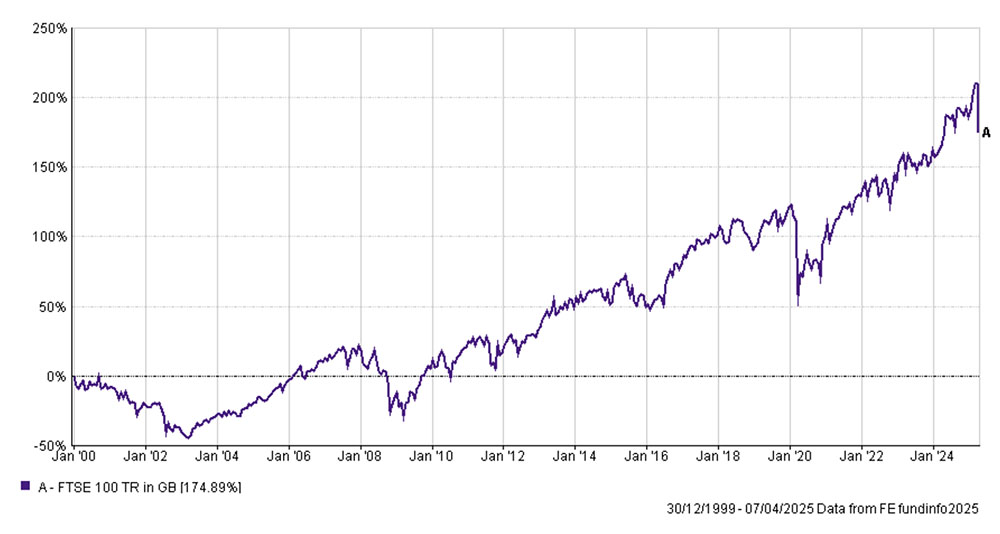This content is for information purposes only. It should not be taken as financial or investment advice. To receive personalised, regulated financial advice regarding your affairs please consult your Financial Planner here at Vesta Wealth in Cumbria, Teesside and across the North of England.
On “Liberation Day” (2 April 2025), US President Donald Trump unveiled a set of global tariffs on around 90 countries and regional blocs, including China and the EU.
The news has sent shockwaves across the media landscape, with many commentators suggesting the tariffs could spark a worldwide economic contraction – and possibly a recession.
What is going on exactly? Should you be worried, and what does this all mean for your money? Our financial advisers offer some answers below.
What are tariffs?
It is important to get the fundamentals in place before discussing the finer details of the “Trump tariffs”. A tariff is a tax applied to goods imported into a country.
For instance, in September 2024, then-President Joe Biden imposed a 100% tariff on electric vehicles (EVs) sold by Chinese firms to US-based customers.
Tariffs can serve multiple purposes. One key reason is to try and prop up (or restore) domestic industries that may have declined under “free trade”.
For example, in the US automotive sector, nearly 86,000 US jobs have been lost since 2020. The reasons for this contraction are varied, but a key variable is intense competition from overseas – particularly China, which enjoys lower costs of production (allowing them to undercut western rivals). Introducing tariffs makes imported goods more expensive, which makes domestically produced goods more competitive.
Why is the media panicking?
This description of tariffs might seem relatively sensible and benign. After all, isn’t the President just looking out for domestic jobs and protecting its industrial base?
One issue with tariffs is that they can cause other countries to retaliate. Indeed, in response to the Liberation Day tariffs on 2 April, China quickly responded with a new 34% tariff on goods imported from the US. Market commentators have suggested these retaliatory threats could spark a global trade war.
The end result is that goods often become more expensive. Clothes, food, cars, footwear and other items get pricier. Meanwhile, wages may not rise to keep up with rising costs. The result can be higher inflation and eroded real incomes.
Higher prices can lead to less consumer spending in an economy. Firms may struggle to sell as many goods, and the lower revenues can lead to cost cutting (e.g. shedding staff, contributing to more unemployment). The end result? Lower growth.
Indeed, this logic underpins much of the recent media melancholy about the UK. Since the US imposed its new 10% tariff on our country (lower than the 20% put on the EU), think tanks like Oxford Economics have downgraded the UK’s economic growth forecast to below 1% in 2025.
Should I be worried?
If you have held investments over the last 20 years, there will have been some points at which you were very nervous.
But the markets march on, and the 2008 financial crisis (and various other major world events) have barely warranted a blip on an otherwise upward trajectory. There is no reason to think that the Trump Tariffs will be any different.

It is possible that the markets (and media) are overstating the impact of the Trump Tariffs on the UK. US exports account for 2.2% of UK GDP. This is much lower than the EU’s 3% average and Germany’s 4%.
The most vulnerable sector is arguably automobiles. 10% of UK exports to the US are cars. In response to Liberation Day, Jaguar Land Rover announced it would suspend shipments to the US for at least two weeks as it decided what to do.
From the UK’s perspective, the broader threat comes from the US and Eurozone possibly falling into recession. This is not a certainty. Moreover, the UK government’s commitment not to raise retaliatory tariffs on the US hopefully means the impact on inflation this year should be minimal.
Much of the current activity in the market is driven by fear or greed, causing investors to buy and sell at the wrong times. The best strategy is to stick with the plan and weather the storm.
Investor sentiment causes the markets to rise and fall, but ultimately, a sound investment strategy, held for the long term, is unlikely to fail.
What should I do?
If you are concerned, please know that our team is there to help and guide you. Bear in mind that the Trump Tariffs do not alter the fundamentals of good financial planning.
In the short term, examine your budget and ensure your income can cover essential spending – even if costs rise overall.
Keep a strong emergency fund in case of harmful unforeseen events, such as job loss (e.g. 3-6 months’ worth of living costs). Make sure your investment strategy and asset allocation are still in line with your time horizons, goals and risk appetite.
Be careful not to try and “time the market” when investing. Most investors will do their best to keep contributing to their portfolio (e.g. once per month) and then try not to watch their investments too closely. If you have questions or concerns, get a second opinion from a financial adviser.
Remember, investor biases like loss aversion are powerful, do not always work in your best interests, and can be exacerbated by negative headlines and social media echo chambers. If the investor “herd” seems to be flocking in one direction, resist the desire to simply follow.
Time will tell how the new tariffs will affect economies and markets. We are living in uncertain times, and the world economic order is arguably shifting in fundamental ways. However, keep your mind on the long-term and remember that markets have historically recovered even if they are volatile in the short term. Stay disciplined and focused on your goals.
Next steps
If you’d like to make sure you’re taking the right steps to safeguard your financial future, please get in touch.

